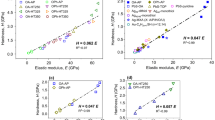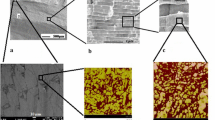Abstract
The local deformation surrounding an indented area of Ensis siliqua mollusk shell is characterized using a Raman spectroscopic technique, the findings of which are related to the material’s mechanical function. Microhardness indentation of four directional planes is used to show the marked anisotropy of the structure, where the outer and inner layers of the shell are found to have a significantly higher microhardness value of 4.82 ± 0.02 GPa, compared with transverse and longitudinal cross-sectional values of 3.00 ± 0.07 GPa. This difference is related to the crossed lamellar microstructure of the shell, which is oriented to provide the maximum resistance to external attack from predators. Nanoindentation of the material shows no such anisotropy, giving mean hardness and modulus values for the four directional planes of 3.86 ± 0.10 GPa and 82.4 ± 2.7 GPa respectively, thereby clarifying the prominent role of microstructure in such materials. Scanning electron microscopy of indented samples shows that plastic deformation and delamination occur to different extents, depending on the orientation of the structure and local microstructural features such as prismatic layers. A Raman spectroscopic technique has been used to map relative deformation in the vicinity of the indents, showing that the amount of plastic or permanent deformation can be quantified, and that material delamination can be distinguished from other forms of deformation such as local cracking. These experimental methods are repeated using samples of non-biogenic aragonite, which act as an analogous material for comparison with the shell. It is proposed that the analysis of microhardness indents using Raman spectroscopy could be applied to other biomaterials exhibiting anisotropy.
Similar content being viewed by others
References
L.T. Kuhn-Spearing, H. Kessler, E. Chateau, R. Ballarini, A.H. Heuer: Fracture mechanisms of the Strombus gigas conch shell: Implications for the design of brittle laminates. J. Mater. Sci. 31, 6583 (1996).
J.D. Currey: Mechanical-properties of mother of pearl in tension. Proc. R. Soc. London B, Biol. Sci. 196, 443 (1977).
J.F.V Vincent: Handbook of Elastic Properties of Solids, Liquids and Gases, Volume III: Elastic Properties of Solids: Biological and Organic Materials, Earth and Marine Sciences (Academic Press, Burlington, MA, 2001), pp. 215–219.
S. Kamat, H. Kessler, R. Ballarini, M. Nassirou, A.H. Heuer: Fracture mechanisms of the Strombus gigas conch shell: II. Micromechanics analyses of multiple cracking and large-scale crack bridging. Acta Mater. 52, 2395 (2004).
O.B. Bøggild: The shell structure of the mollusks. Kong. Dsk. Vidensk. Selsk. Skr., Natur. Math. Afd. 9, 112, 5 (1930).
S. Kamat, X. Su, R. Ballarini, A.H. Heuer: Structural basis for the fracture toughness of the shell of the conch Strombus gigas. Nature 405, 1036 (2000).
X. Li, P. Nardi: Micro/nanomechanical characterization of a natural nanocomposite material—The shell of Pectinidae. Nanotechnology 15, 211 (2004).
Y. Dauphin, N. Guzman, A. Denis, J.P. Cuif, L. Ortlieb: Microstructure, nanostructure and composition of the shell of Concholepas concholepas (Gastropoda, Muricidae). Aquatic Living Resources 16, 95 (2003).
S.J. Eichhorn, D.J. Scurr, S.P. Thompson, M. Golshan, R.J. Cernik: The role of residual stress in the fracture properties of a natural ceramic. J. Mater. Chem. 15, 947 (2005).
M.Y. He, J.W. Hutchinson: Crack deflection at an interface between dissimilar elastic materials. Int. J. Sol. Struct. 25, 1053 (1989).
R.F. Robinson, C.A. Richardson: The direct and indirect effects of suction dredging on a razor clam (Ensis arcuatus) population. ICES J. Marine Sci. 55, 970 (1998).
M.S. Amer: Raman spectroscopy investigations of functionally graded materials and inter-granular mechanics. Int. J. Sol. Struct. 42, 751 (2005).
J.I. Steinfeld: Molecules and Radiation: An Introduction to Molecular Spectroscopy (The MIT Press, Cambridge, MA, 1979), pp. 134–144.
V.K. Mitra, W.M. Risen, R.H. Baughman: A laser Raman study of the stress dependence of vibrational frequencies of a monocrystalline polydiacetylene. J. Chem. Phys. 66, 2731 (1977).
C. Lin, L. Liu: Post-aragonite phase transitions in strontianite and cerussite—A high pressure Raman spectroscopic study. J. Phys. Chem. Solids 58, 977 (1997).
R. Frech, E.C. Wang, J.B. Bates: The IR spectra of CaCO3 (aragonite). Spectrochim. Acta, Part A 36, 915 (1980).
B.J.F Bruet, H.J. Qi, M.C. Boyce, R. Panas, K. Tai, L. Frick, C. Ortiz: Nanoscale morphology and indentation of individual nacre tablets from the gastropod mollusk Trochus niloticus. J. Mater. Res. 20, 2400 (2005).
G. Weidmann, P. Lewis, N. Reid: Structural Materials, 3rd ed. (Butterworth Heinemann, Open University Press, London, UK, 1996), pp. 100–102.
Y. Dauphin, A. Denis: Structure and composition of the aragonitic crossed lammellar layers in six species of bivalvia and gastropoda. Comp. Biochem. Physiol., A 126, 367 (2000).
J.D. Taylor, M. Layman: The mechanical properties of bivalve (Molluska) shell structures. Palaeontology 15, 256 (1972).
D.F. Hou, G.S. Zhou, M. Zheng: Conch shell structure and its effect on mechanical behaviours. Biomaterials 25, 751 (2004).
H.J. Gao, B.H. Ji, J.L. Jager, E. Arzt, P. Fratzl: Materials become insensitive to flaws at nanoscale: Lessons from nature. Proc. Natl. Acad. Sci. U.S.A. 100, 5597 (2003).
W.C. Oliver, G.M. Pharr: An improved technique for determining hardness and elastic modulus using load and displacement sensing indentation experiments. J. Mater. Res. 7, 1564 (1992).
R.F.S Hearmon: The elastic constants of anisotropic materials. Rev. Mod. Phys. 18, 409 (1946).
M.L. Huggins: The crystal structures of aragonite (CaCO3) and related minerals. Phys. Rev. 19, 354 (1922).
S.A. Wainwright: Stress and design in bivalved mollusk shell. Nature 224, 777 (1969).
Author information
Authors and Affiliations
Corresponding author
Rights and permissions
About this article
Cite this article
Scurr, D.J., Eichhorn, S.J. Analysis of local deformation in indented Ensis Siliqua mollusk shells using Raman spectroscopy. Journal of Materials Research 21, 3099–3108 (2006). https://doi.org/10.1557/jmr.2006.0382
Received:
Accepted:
Published:
Issue Date:
DOI: https://doi.org/10.1557/jmr.2006.0382




